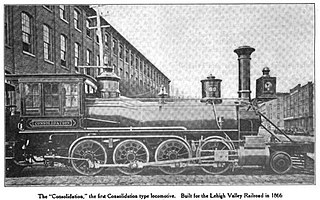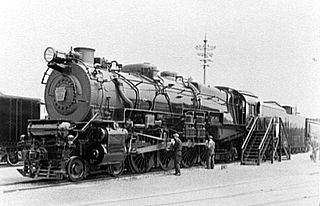
The Prosperity Special was a notable shipment of twenty 2-10-2 Baldwin steam locomotives in May and June 1922.

The Prosperity Special was a notable shipment of twenty 2-10-2 Baldwin steam locomotives in May and June 1922.
The shipment of twenty locomotives made by the Baldwin Locomotive Works for the Southern Pacific Railroad, was part of an order for fifty. [1] This was the most remarkable single train of locomotives ever hauled across the country until then. The train itself was nearly half a mile long without the pulling and pushing engines. It departed on 22 May 1922 from Eddystone, bound for St. Louis on the Pennsylvania Railroad. It went then via the St. Louis Southwestern Railway to Corsicana. The train moved then via Southern Pacific to Los Angeles, where it arrived in June 1922. [2]
These locomotives were subsequently used in heavy freight service on heavy grades in the Far West. They are carried on five pairs of driving wheels, with a two-wheeled truck at the front and rear. The large amount of weight on the driving wheels gives a great hauling capacity, while the trucks support the ends of the locomotive and guide it into curves and switches. Each locomotive was nearly 100 feet (30 m) in length, weighing 621,000 pounds (282 t). so that the entire train of twenty weighed in excess of 6,000 tons. The tenders had cylindrical water tanks and a smaller tank at the front end to carry the oil fuel which all Southern Pacific locomotives burn. The oil was sprayed into the furnace by a jet of steam and the fire is controlled by means of valves placed within easy reach of the fireman. [1]
Various modern devices were applied to increase the efficiency and capacity of the locomotives. Before entering the boiler, the feed water was heated; and the steam was also highly superheated before it entered the steam cylinders. An auxiliary engine known as a booster was attached to the rear truck for increasing the hauling power when starting heavy trains and climbing steep grades. The locomotive was reversed by a power operated device which relieved the engineer of considerable manual labor. [1]
It was only possible to haul twenty of these heavy locomotives in a single train, and it required several pulling and pushing locomotives on level stretches, while in passing over the Allegheny Mountains west of Altoona, additional helping power was needed. No less than six engines were necessary to move the train around the Horseshoe Curve. Throughout the entire journey, each locomotive was manned by an experienced engineer, who was personally in charge of the locomotive to which he was assigned. [1]
The departure of this complete train of locomotives, the most valuable ever moved in the United States as a single unit until then, was a most memorable event at the works where they were built. Many people from Washington, Pennsylvania, all parts of Pennsylvania and adjoining States, including officials from the Southern Pacific and other railways of the country witnessed the starting. By reason of the care which had to be exercised in the handling of this train, its movements were in the daytime only. No attempt at speed was made at any point, and this also permitted the train to be reviewed by millions of people throughout its long journey. At many of the stopping places and in a large number of cities through which it passed, State and Municipal authorities, officers and members of Chambers of Commerce, Boards of Trade, commercial and industrial organizations, public school authorities and local trade and business associations made arrangements to review the train as it passed through their localities. At the night stopping places, opportunity was afforded for a close inspection of the locomotives. [1]

A steam locomotive is a locomotive that provides the force to move itself and other vehicles by means of the expansion of steam. It is fuelled by burning combustible material to heat water in the locomotive's boiler to the point where it becomes gaseous and its volume increases 1,700 times. Functionally, it is a steam engine on wheels.

A Mallet locomotive is a type of compound articulated steam locomotive, invented by the Swiss engineer Anatole Mallet (1837–1919).

A tender or coal-car is a special rail vehicle hauled by a steam locomotive containing its fuel and water. Steam locomotives consume large quantities of water compared to the quantity of fuel, so their tenders are necessary to keep them running over long distances. A locomotive that pulls a tender is called a tender locomotive. Locomotives that do not have tenders and carry all their fuel and water on board the locomotive itself are called tank locomotives or tank engines.

Under the Whyte notation for the classification of steam locomotives, 4-6-2 represents the wheel arrangement of four leading wheels on two axles, six powered and coupled driving wheels on three axles and two trailing wheels on one axle. The 4-6-2 locomotive became almost globally known as a Pacific type after a New Zealand locomotive that was shipped across the Pacific Ocean.

Under the Whyte notation for the classification of steam locomotives, 4-8-2 represents the wheel arrangement of four leading wheels, eight powered and coupled driving wheels and two trailing wheels. This type of steam locomotive is commonly known as the Mountain type, though the New York Central Railroad used the name Mohawk for their 4-8-2s.

A 2-8-8-4 steam locomotive, under the Whyte notation, has two leading wheels, two sets of eight driving wheels, and a four-wheel trailing truck. The type was generally named the Yellowstone, a name given it by the first owner, the Northern Pacific Railway, whose lines ran near Yellowstone National Park. Seventy-two Yellowstone-type locomotives were built for four U.S. railroads.

Under the Whyte notation for the classification of steam locomotives, 4-8-4 represents the wheel arrangement of four leading wheels on two axles, eight powered and coupled driving wheels on four axles and four trailing wheels on two axles. The type was first used by the Northern Pacific Railway, and initially named the Northern Pacific, but railfans and railroad employees have shortened the name since its introduction. It is most-commonly known as a Northern.
Under the Whyte notation for the classification of steam locomotives, 2-10-0 represents the wheel arrangement of two leading wheels on one axle, ten powered and coupled driving wheels on five axles, and no trailing wheels. This arrangement was often named Decapod, especially in the United States, although this name was sometimes applied to locomotives of 0-10-0 "Ten-Coupled" arrangement, particularly in the United Kingdom. Notable German locomotives of this type include the war locomotives of Class 52.
Under the Whyte notation for the classification of steam locomotives, 2-10-2 represents the wheel arrangement of two leading wheels, ten powered and coupled driving wheels, and two trailing wheels. In the United States and elsewhere the 2-10-2 is known as the Santa Fe type, after the Atchison, Topeka and Santa Fe Railway that first used the type in 1903.

Under the Whyte notation for the classification of steam locomotives, 4-2-0 represents the wheel arrangement of four leading wheels on two axles, two powered driving wheels on one axle and no trailing wheels. This type of locomotive is often called a Jervis type, the name of the original designer.

Under the Whyte notation for the classification of steam locomotives, 2-8-0 represents the wheel arrangement of two leading wheels on one axle, usually in a leading truck, eight powered and coupled driving wheels on four axles, and no trailing wheels. In the United States and elsewhere, this wheel arrangement is commonly known as a Consolidation, after the Lehigh and Mahanoy Railroad’s Consolidation, the name of the first 2-8-0.

The M1 was a class of steam locomotive of the Pennsylvania Railroad (PRR). It was a class of heavy mixed-traffic locomotives of the 4-8-2 "Mountain" arrangement, which uses four pairs of driving wheels with a four-wheel guiding truck in front for stability at speed and a two-wheel trailing truck to support the large firebox needed for sustained power. Although built for both passenger and freight work, they spent most of their service lives hauling heavy high-speed freight trains. Many PRR men counted the M1 class locomotives as the best steam locomotives the railroad ever owned.
A 2-8-8-2, in the Whyte notation for describing steam locomotive wheel arrangements, is an articulated locomotive with a two-wheel leading truck, two sets of eight driving wheels, and a two-wheel trailing truck. The equivalent UIC classification is, refined to Mallet locomotives, (1'D)D1'. These locomotives usually employ the Mallet principles of articulation—with the rear engine rigidly attached to the boiler and the front engine free to rotate—and compounding. The 2-8-8-2 was a design largely limited to American locomotive builders. The last 2-8-8-2 was retired in 1962 from the N&W's roster, two years past the ending of steam though steam was still used on steel mill lines and other railroads until 1983.

The PRR S1 class steam locomotive was a single experimental duplex locomotive of the Pennsylvania Railroad. It was designed to demonstrate the advantages of duplex drives espoused by Baldwin Chief Engineer Ralph P. Johnson. It was the longest and heaviest rigid frame reciprocating steam locomotive that was ever built. The streamlined Art Deco styled shell of the locomotive was designed by Raymond Loewy.
Under the Whyte notation for the classification of steam locomotives by wheel arrangement, a 2-6-6-2 is a locomotive with one pair of unpowered leading wheels, followed by two sets of three pairs of powered driving wheels and one pair of trailing wheels. The wheel arrangement was principally used on Mallet-type articulated locomotives, although some tank locomotive examples were also built. A Garratt locomotive or Golwé locomotive with the same wheel arrangement is designated 2-6-0+0-6-2 since both engine units are pivoting.

Under the Whyte notation for the classification of steam locomotives by wheel arrangement, 4-10-2 represents the arrangement of four leading wheels, ten powered and coupled driving wheels and two trailing wheels. In South Africa, where the wheel arrangement was first used, the type was known as a Reid Tenwheeler. In the United States of America it was known as a Southern Pacific on the Southern Pacific Railroad and as an Overland on the Union Pacific Railroad.
Under the Whyte notation for the classification of steam locomotives, a 2-8-8-8-4 has two leading wheels, three sets of eight driving wheels, and four trailing wheels.
A triplex locomotive was a steam locomotive that divided the driving force on its wheels by using three pairs of cylinders to drive three sets of driving wheels. Any such locomotive will inevitably be articulated. All triplex locomotives built were of the Mallet type, but with an extra set of driving wheels under the tender. The concept was extended to locomotives with four, five or six sets of drive wheels. However, these locomotives were never built, except for one quadruplex locomotive in Belgium.
The Victorian Railways V Class is a steam locomotive, used on the Victorian Railways in the period 1900-1930.

The South African Railways Class 16E 4-6-2 of 1935 is a class of passenger steam locomotive.